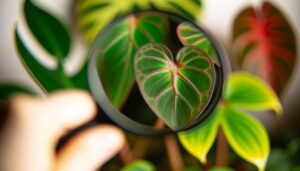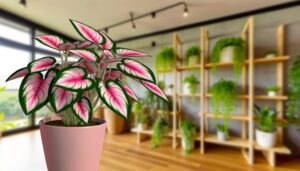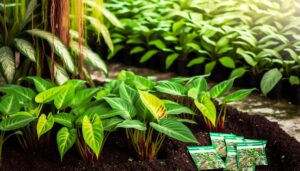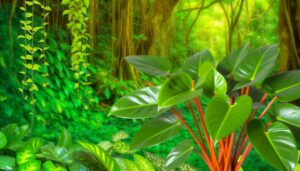What Is the Growth Rate of Philodendron Billietiae?
Philodendron billietiae demonstrates a moderate growth rate, usually producing several new leaves per growing season. Under ideal conditions, including temperatures between 70-85°F (21-29°C) and humidity levels of 60-80%, the plant thrives.
It requires well-draining soil with a pH of 5.5-6.5 and balanced fertilization. Adequate moderate to bright indirect light is essential for efficient photosynthesis and robust growth.
Seasonal variations influence its growth, with accelerated development in spring and summer and slower growth during fall and winter. For those interested in specific growth conditions and maintenance practices that enhance its development, further insights await.
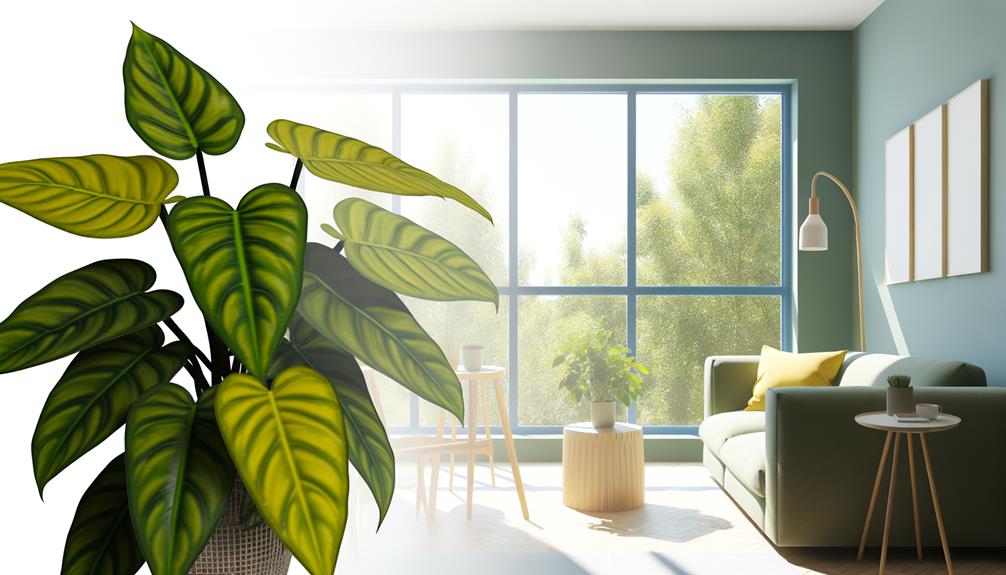
Key Takeaways
- Philodendron billietiae typically grows at a moderate rate.
- Optimal growth occurs in temperatures between 70-85°F (21-29°C).
- High humidity levels of 60-80% enhance its growth.
- Bright, indirect light is crucial for maximizing growth rate.
- Vigorous growth is observed in spring and summer.
Ideal Growth Conditions
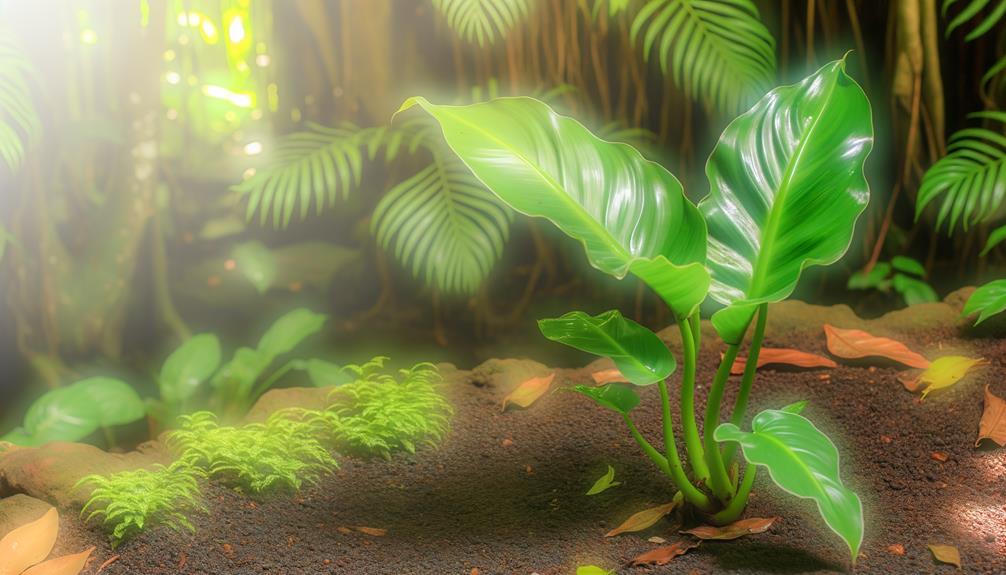
To achieve prime growth for Philodendron Billietiae, it is essential to maintain specific environmental conditions, including adequate light, temperature, humidity, and soil composition.
The ideal temperature range for this tropical plant is between 70-85°F (21-29°C), ensuring a stable environment that mimics its native habitat. Humidity levels should be kept at 60-80%, as higher moisture content in the air supports strong foliage development.
The soil must be well-draining yet retain enough moisture to prevent root desiccation; a mix of peat, perlite, and orchid bark is recommended to achieve this balance. Regular monitoring of these parameters is essential, as deviations can greatly hinder the plant's growth rate and overall health.
Impact of Light
The growth rate of Philodendron billietiae is greatly influenced by light conditions, with best light exposure being crucial for maximizing its development.
Studies indicate that moderate to bright indirect light is ideal, as excessive direct sunlight can lead to photoinhibition, while insufficient light results in etiolation.
In addition, light intensity directly impacts photosynthetic efficiency, affecting the overall biomass accumulation and morphological characteristics of the plant.
Optimal Light Conditions
Understanding the best light conditions is essential for maximizing the growth rate of Philodendron Billietiae, as light intensity and duration directly influence photosynthetic efficiency and overall plant health. Optimum light conditions guarantee that the plant can effectively convert light energy into chemical energy, promoting robust growth and vibrant foliage.
For peak performance, consider the following factors:
- Light Spectrum: Maintain a balanced spectrum encompassing both red and blue wavelengths to support photosynthesis and leaf development.
- Duration: Aim for 10-12 hours of light exposure daily to mimic natural tropical environments.
- Positioning: Place the plant near east or west-facing windows to receive indirect, filtered sunlight.
- Artificial Lighting: Utilize full-spectrum LED grow lights if natural light is insufficient, ensuring consistent light quality and duration.
Light Intensity Effects
In evaluating the impact of light intensity on Philodendron Billietiae, it becomes evident that varying levels of light play a significant role in modulating the plant's photosynthetic rate and subsequent growth dynamics.
High light intensity generally enhances photosynthetic activity, leading to accelerated growth rates. Conversely, insufficient light can result in stunted growth and etiolation, characterized by elongated stems and pale leaves.
However, excessive light may cause photodamage, impairing chlorophyll function and reducing overall plant vitality. Optimal light conditions, typically bright, indirect light, ensure maximum photosynthetic efficiency without the detrimental effects of excessive radiation.
Understanding the nuanced relationship between light intensity and photosynthesis is essential for optimizing the growth and health of Philodendron Billietiae.
Importance of Humidity
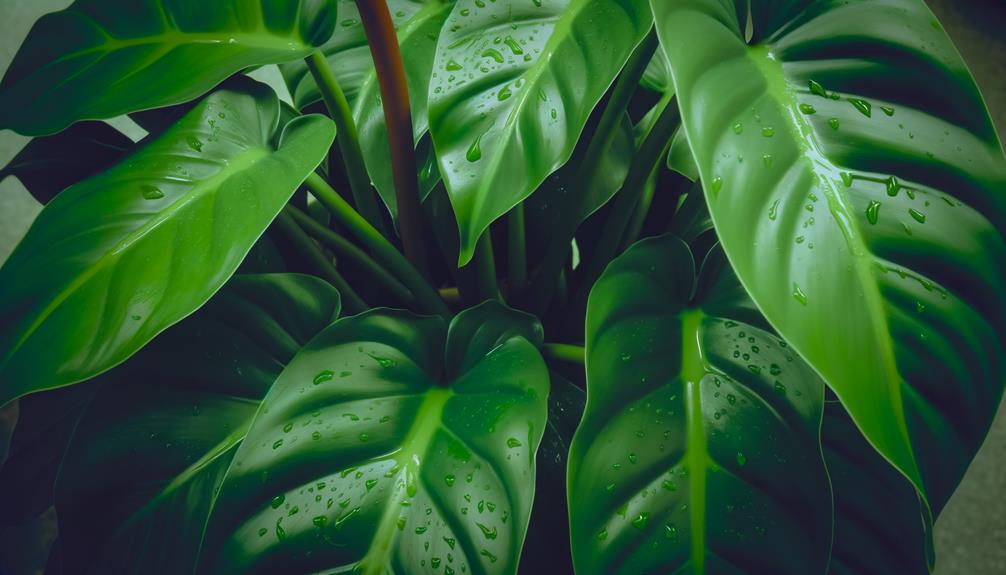
Maintaining best humidity levels is important for the robust growth and health of Philodendron Billietiae. This tropical plant thrives in environments with consistently high moisture in the air, ideally ranging from 60% to 80%. Low humidity can lead to slower growth rates, leaf browning, and increased susceptibility to pests.
Conversely, excessively high humidity without adequate ventilation can foster fungal diseases. To maintain appropriate humidity, indoor growers can employ methods such as humidifiers, pebble trays, or grouping plants together.
Understanding these factors is crucial for ensuring the plant's vitality.
Soil and Nutrients
Ideal soil composition and nutrient management are fundamental to promoting the vigorous growth of Philodendron Billietiae. This tropical aroid thrives in a well-draining, aerated substrate, such as a mix of peat, perlite, and orchid bark, which ensures adequate oxygenation of the roots.
The soil pH should be slightly acidic, ideally between 5.5 and 6.5, to optimize nutrient uptake. Regular fertilization with a balanced, water-soluble fertilizer, rich in nitrogen, phosphorus, and potassium, is essential for robust growth. Micronutrients, including magnesium and calcium, also play a vital role in maintaining leaf health and overall plant vigor.
Periodic soil amendments with organic matter, like compost, can enhance nutrient availability and microbial activity, further supporting the plant's development.
Watering Practices
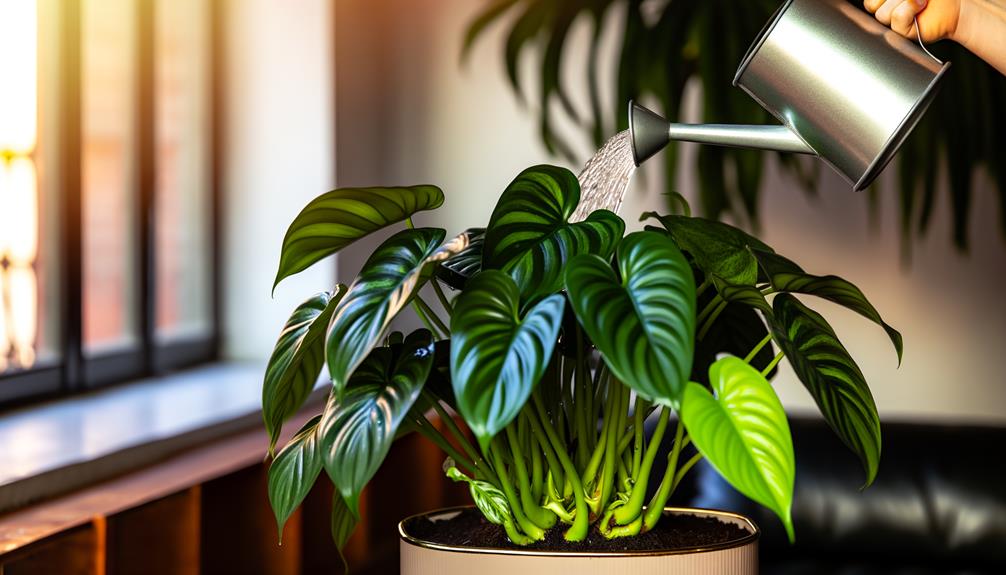
Proper watering practices are essential to the health and growth rate of Philodendron Billietiae, necessitating a careful balance between consistent moisture and adequate drainage to prevent root rot. Precise hydration is critical, as overwatering can lead to fungal infections and under-watering can stunt growth. Employing a well-drained soil mix aids in maintaining this equilibrium.
Water Frequency: Water when the top 1-2 inches of soil are dry.
Water Quality: Use filtered or distilled water to avoid chlorine and fluoride.
Humidity: Maintain humidity levels between 60-80% to mimic tropical conditions.
Drainage: Ensure pots have proper drainage holes to prevent water stagnation.
These strategies collectively support optimal hydration, leading to a vigorous growth rate for Philodendron Billietiae.
Seasonal Growth Patterns
Understanding the seasonal growth patterns of Philodendron Billietiae is important, as this plant displays distinct phases of vegetative development and dormancy aligned with environmental changes throughout the year.
During the warmer months, typically spring and summer, Philodendron Billietiae enters a vigorous growth phase, characterized by rapid elongation of stems and expansion of its large, heart-shaped leaves. This period of accelerated growth is driven by increased light, longer daylight hours, and best temperatures.
Conversely, in the cooler months of fall and winter, the plant's growth rate noticeably slows down, entering a quasi-dormant state. During this dormancy, metabolic activities slow down, and the plant conserves energy, requiring reduced watering and minimal nutrient input to maintain its health.
Understanding these patterns is important for optimal care.
Conclusion
To summarize, the growth rate of Philodendron billietiae, akin to a finely-tuned orchestra, is greatly impacted by a combination of factors:
ideal light exposure, suitable humidity levels, nutrient-rich soil, and consistent watering.
Seasonal changes also play a crucial role, determining times of increased growth and dormancy.
Comprehending and carefully controlling these factors guarantees strong development and health, allowing this tropical plant to flourish and achieve its complete decorative capacity in cultivated settings.

